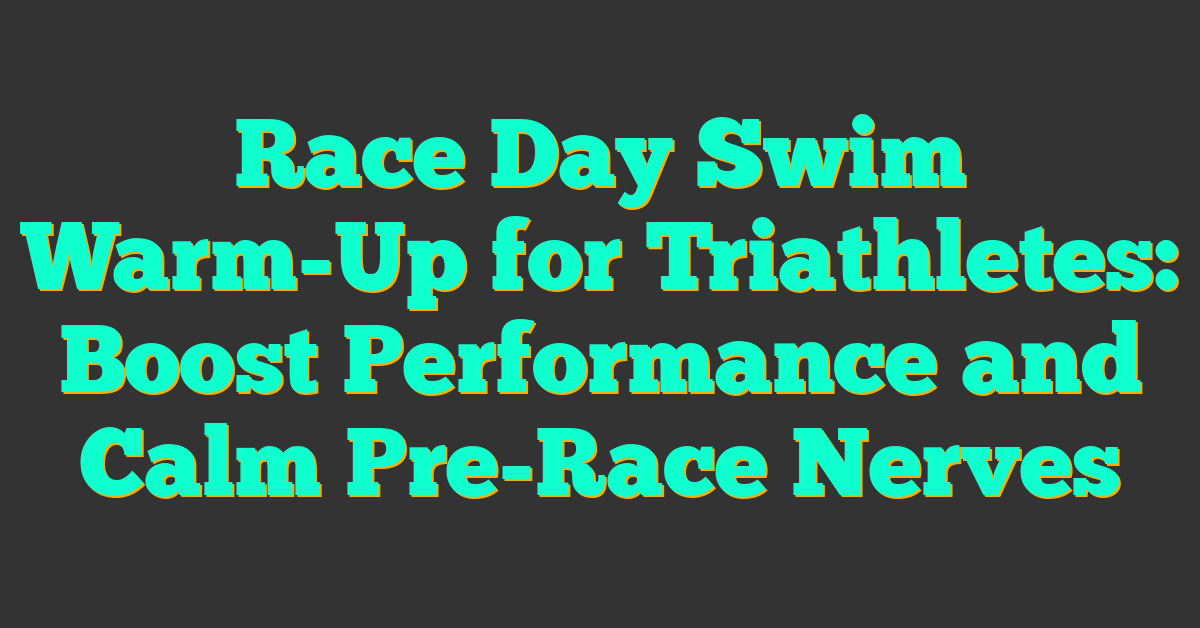Race day is finally here and the swim leg is just moments away. I’ve learned that a good warm-up in the water can make all the difference between a smooth start and feeling rushed or tense. It’s not just about loosening up muscles but also about getting my mind focused and ready to dive in with confidence.

Over the years I’ve found that a proper swim warm-up helps me settle my breathing and find my rhythm before the race officially starts. Whether you’re a seasoned triathlete or tackling your first race, having a simple warm-up routine can boost your performance and calm those pre-race jitters. Let’s talk about how to make your race day swim warm-up efficient and effective so you can start strong and swim with ease.
Importance of Race Day Swim Warm-Up for Triathletes
I emphasize the race day swim warm-up as a key factor in setting the tone for the entire triathlon. Warming up prepares the muscles involved in swimming—such as the shoulders, back, and core—by increasing blood flow and flexibility. It prevents sudden strain and reduces the risk of injury at the start of the race.
I also recognize how a warm-up sharpens the nervous system, helping maintain focus and improving reaction times once the race begins. It allows the body to adjust from resting mode to race mode, which is essential for establishing an efficient stroke rhythm and steady breathing under race conditions.
I notice swimmers who skip or shorten their warm-up often face challenges settling into pace or controlling anxiety, which can negatively affect performance. In contrast, a consistent warm-up routine calms pre-race nerves, boosts confidence, and helps maintain physical readiness.
I recommend triathletes include dynamic stretches, easy swimming drills, and short bursts of faster swimming in their warm-up. These elements prepare both the mind and the body, ensuring the swim leg starts smoothly and strongly.
Preparing Mentally and Physically for the Swim
Building mental and physical readiness before the swim keeps performance sharp and anxiety low. This preparation bridges the gap between warm muscles and a focused mind.
Visualization Techniques
Visualization helps me enter the race with a clear focus. I imagine the swim course, picturing each stroke and turn with precision. Seeing myself navigating the water smoothly reduces uncertainty, letting me react calmly if unexpected situations arise. I focus on maintaining steady rhythm and efficient breathing. Visualizing a strong start builds confidence, especially when race day nerves try to take over.
Breathing Exercises to Reduce Anxiety
Breathing exercises calm my nervous system and sharpen focus before the swim. I use slow, deep breaths—inhale for four counts, hold for four, exhale for six—to lower heart rate and relax muscles. This technique reduces tension in the chest and shoulders, preparing me to control my breathing rhythm once the race begins. Controlled breathing keeps anxiety from stealing mental energy and helps maintain steady oxygen flow during the swim.
Essential Warm-Up Exercises Before the Swim
A proper warm-up before race day swim sets the tone for success in the water. I focus on dynamic movements and targeted drills that get both the body and mind ready for the demands ahead.
Dynamic Stretching for Swimmers
Dynamic stretching activates key muscle groups used in swimming, including shoulders, back, and core. I incorporate arm circles, shoulder rolls, and torso twists to enhance blood flow and joint mobility. Leg swings and hip openers prepare the lower body, improving balance and streamline position in the water. These movements last about 5 to 7 minutes and eliminate stiffness without tiring the muscles. When dynamic stretching happens immediately before the swim, it maximizes muscle readiness and reduces injury risk.
Swimming Drills to Activate Muscles
Swimming drills sharpen neuromuscular coordination and reinforce efficient stroke patterns before the race begins. I use drills like catch-up, fingertip drag, and sculling to engage shoulder stability and refine arm positioning. Short intervals of easy freestyle with controlled breathing reset pace and breathing rhythm. Including 2 to 3 sets of 25 to 50 yards at a moderate pace activates fast-twitch muscle fibers. This approach boosts confidence and primes the nervous system for explosive performance once the race starts.
Timing and Duration of the Swim Warm-Up
Getting the timing and duration of the swim warm-up right plays a crucial role in launching the swim leg with strength and confidence. It’s about preparing the body and mind, not draining energy before the race even begins.
Ideal Warm-Up Length
I recommend keeping the swim warm-up between 10 and 20 minutes. This window lets you activate muscles, elevate heart rate, and settle your breathing without causing fatigue. Around 400 to 600 meters of easy swimming mixed with dynamic drills—like catch-up and fingertip drag—hits the balance perfectly. Adding a few short bursts, such as 4 × 25 meters at race pace with rest, sharpens your neuromuscular response and primes your nervous system. If the warm-up goes beyond 20 minutes, energy stores tap out, and the benefits reverse.
When to Start Your Warm-Up Before the Race
I advise starting the swim warm-up about 30 to 45 minutes before your wave’s start time. This timing provides room for your routine, including stretching, drills, and rest, while keeping muscles loose. Arriving too early or warming up too soon means you risk cooling down before the gun. Arriving late leaves no time to adequately prepare. After warming up, I recommend staying active with light movements or slow swimming until the start, so your body stays ready. This timing setup sharpens your focus, stabilizes your breathing, and lets you hit race mode right on time.
Tips for an Effective Race Day Swim Warm-Up
An effective swim warm-up sets the tone for the entire triathlon swim leg. I’ve seen how adjusting details in the warm-up can make a big difference in performance. Keeping these tips in mind ensures the body and mind stay ready to perform at their best.
Adjusting Warm-Up Based on Water Temperature
Cold water requires a longer, gentle warm-up to gradually raise muscle temperature and prevent shock. I recommend starting with dynamic stretching on land, like arm circles and torso twists, followed by easy swimming drills. Swimming for 10 to 15 minutes at a relaxed pace activates muscles without expending excess energy. In colder conditions, I add several short bursts of faster swimming to stimulate blood flow further and prepare the nervous system.
Warm water demands a different approach. Since muscles loosen quickly, I keep the warm-up shorter—around 8 to 12 minutes—and avoid overdoing intense strides. Overheating before the start can cause fatigue, so I focus on smooth, controlled strokes and deep breathing exercises to stay calm and maintain rhythm.
Staying Warm Between Warm-Up and Race Start
Staying warm between warm-up and the race start is critical to preserving the benefits of the pre-swim routine. I always recommend wearing a waterproof jacket or robe while waiting; insulated layers trap heat without causing sweat buildup. If possible, keep moving lightly—jogging in place or doing gentle arm swings—to maintain circulation.
« Race Day Nutrition Timing Tips: Boost Your Energy and Performance from Start to Finish
Race Outfit Tips for Comfort: How to Stay Stylish and Pain-Free on Race Day »
I also bring a thermal blanket as a backup, especially during cooler weather or long wait times. If the race allows, hopping back in the wetsuit or taking a few easy strokes shortly before the start can prevent stiffness. Managing this transition carefully keeps muscles ready to explode into action when the swim begins.
Common Mistakes to Avoid During Warm-Up
Skipping the warm-up completely often leads to stiff muscles and higher anxiety at the swim start. Neglecting this essential routine can cause slower reaction times and poor pacing. Starting the warm-up too late reduces its effectiveness, making it harder to regain focus and rhythm before race time. I always advise beginning your warm-up at least 30 minutes before the race to avoid this.
Overdoing the warm-up causes fatigue that weakens muscles during the swim. Spending more than 20 minutes or pushing hard during drills drains energy reserves. I focus on keeping the intensity moderate and the duration within 10 to 20 minutes to maintain freshness.
Rushing through dynamic stretches limits blood flow and muscle activation. Skipping arm circles, shoulder rolls, or torso twists increases injury risk. I emphasize slow, controlled movements to awaken each muscle group effectively without causing early fatigue.
Ignoring water temperature adjustments disrupts muscle readiness. Warming up in cold water requires longer, gentler swims, while hot water demands a shorter routine to prevent overheating. I customize warm-ups depending on weather and water conditions to preserve optimal muscle function.
Failing to stay warm between warm-up and race start leads to cooled muscles and tension. Removing warmup gear too soon or sitting still for long periods drops body temperature. I recommend wearing a waterproof jacket or robe and doing light movement to keep circulation steady until the swim begins.
Neglecting mental preparation during warm-up reduces focus and race confidence. Skipping visualization or controlled breathing exercises leaves nerves unchecked. I pair physical warm-up with mental drills to sharpen concentration and calm pre-race jitters for peak performance.
By avoiding these mistakes, triathletes keep their bodies primed and minds sharp, ensuring a strong, confident swim start every time.
Conclusion
A well-planned swim warm-up isn’t just about loosening muscles—it’s about setting the tone for your entire race. When I take the time to warm up properly, I feel more in control, calm, and ready to tackle the swim with confidence.
Remember, it’s not about rushing or overdoing it but finding the right balance that suits your body and the conditions. Trust your routine, listen to your body, and give yourself that extra edge on race day.
With the right warm-up, you’ll dive in feeling prepared, focused, and ready to swim strong from the very first stroke.










